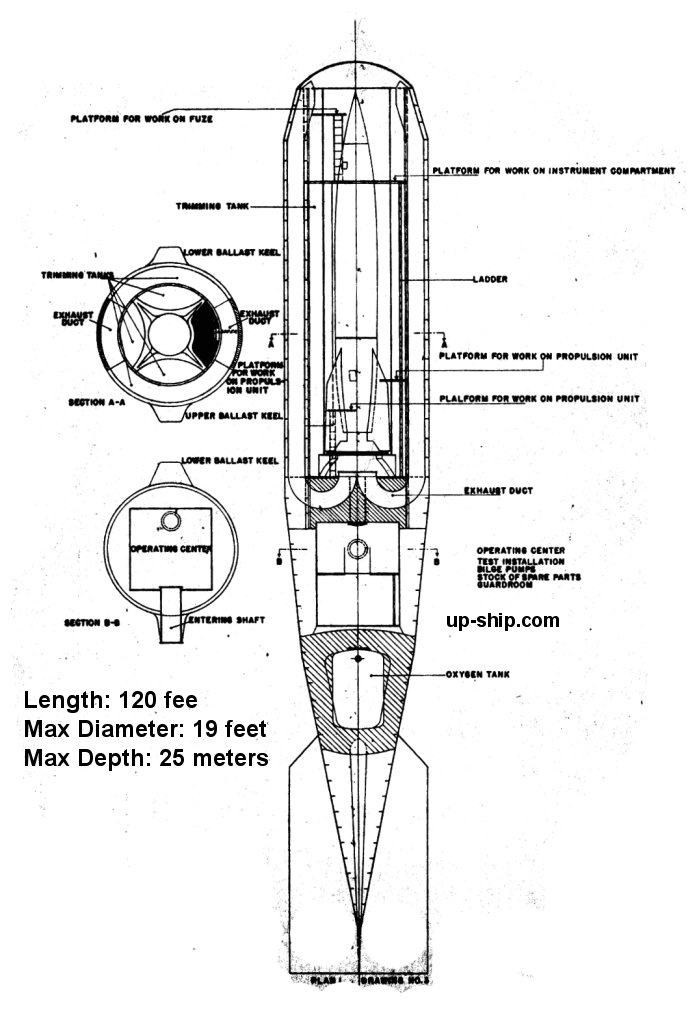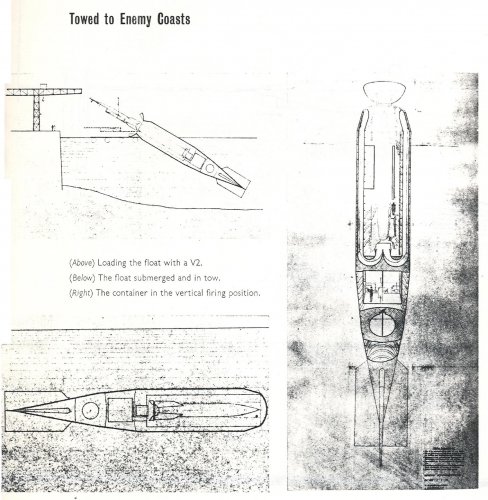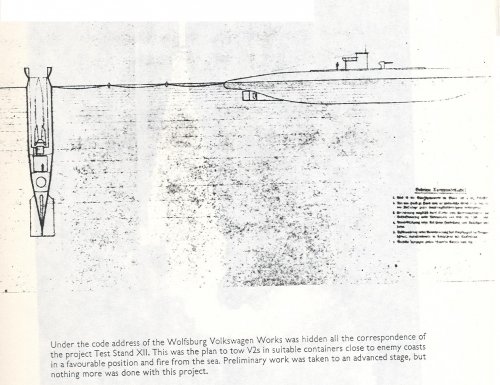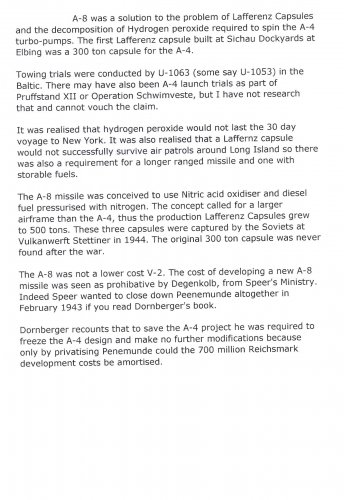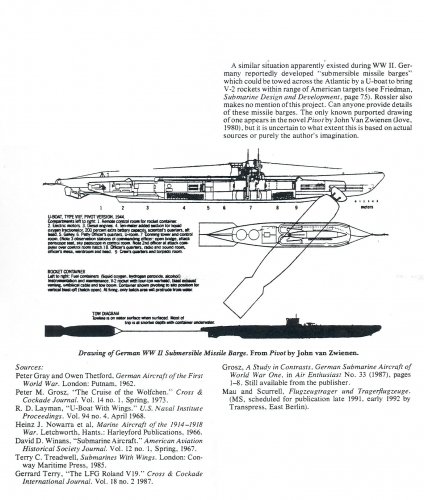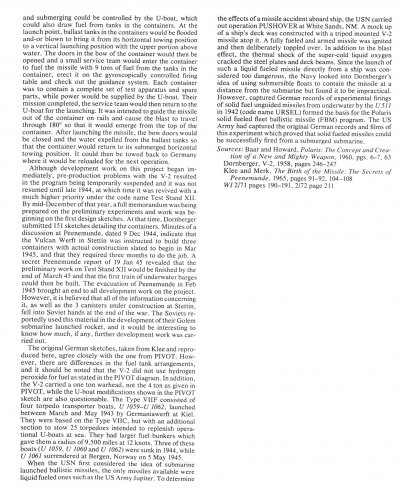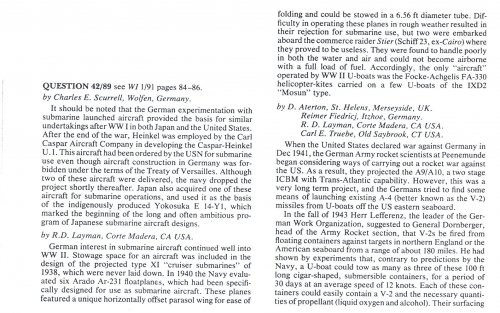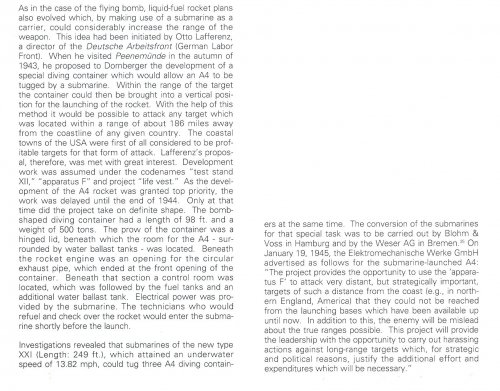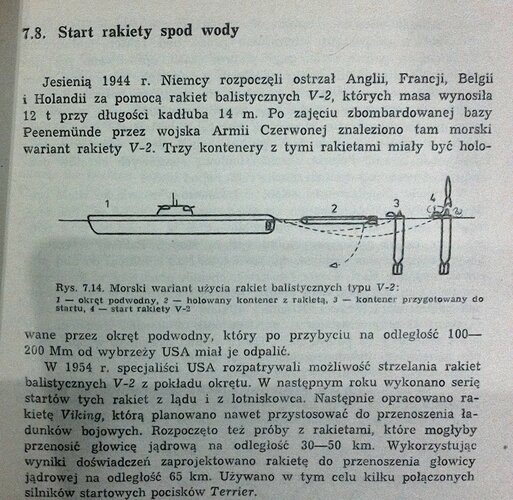You are using an out of date browser. It may not display this or other websites correctly.
You should upgrade or use an alternative browser.
You should upgrade or use an alternative browser.
Prüfstand XII: submarine launched V-2 rockets
- Thread starter Orionblamblam
- Start date
- Status
- Not open for further replies.
- Joined
- 13 August 2007
- Messages
- 7,124
- Reaction score
- 6,433
That also called "Projekt Schwimmweste" (Project life jacket)
after some German literature it was also part of "Amerika Bomber Projekt"
were a German Sub pulls one V-2 cannisters to U.S. Coastline
the chance to launch the rocket was Zero, because the U.S. Navy gona bomb if the Sub show up.
after some German literature it was also part of "Amerika Bomber Projekt"
were a German Sub pulls one V-2 cannisters to U.S. Coastline
the chance to launch the rocket was Zero, because the U.S. Navy gona bomb if the Sub show up.
- Joined
- 11 March 2006
- Messages
- 8,606
- Reaction score
- 3,045
It was very worthwhile project ! It kept several designers/engineers/draughtsman busy and
away from the front and so ... alive . And in some way it used up resources (at least in the
field of design and construction), that, if better used, could have prolonged the war.
So, yes, it was a good project.
BTW, I'm not sure, but I think I've seen a similar concept from post-war times ?
away from the front and so ... alive . And in some way it used up resources (at least in the
field of design and construction), that, if better used, could have prolonged the war.
So, yes, it was a good project.
BTW, I'm not sure, but I think I've seen a similar concept from post-war times ?
Jemiba said:BTW, I'm not sure, but I think I've seen a similar concept from post-war times ?
The idea has arisen just in the last few years, several times.
This is the Laffarenz Project which had a V-2 in a container to be towed by a U-Boat. Although the containers were built, it is unclear if an attempt was made. Pruefstand XII is a reference to Test Stand 12 at Peenemunde which has been mentioned in the literature but photographs have not surfaced.
Ed
Ed
K
Kiwiguy
Guest
Michel Van said:That also called "Projekt Schwimmweste" (Project life jacket)
after some German literature it was also part of "Amerika Bomber Projekt"
were a German Sub pulls one V-2 cannisters to U.S. Coastline
the chance to launch the rocket was Zero, because the U.S. Navy gona bomb if the Sub show up.
Correct Michel the proper name was Projekt Schwimmweste (project swim vest) and also known as Apparat F. From December 1944 Dr Dickmann led a team of engineers to create Lafferenz capsules. It's more commonly known as Pruffstand XII.
Chance to launch was not necessarily zero. A typical A-4 had a range of about 190 km, but the Lafferenz was intended to use the A-8 missile with about 600 km range. The greater stand off range could have assisted it's survival.
The classic V-2 required hydrogen peroxide to spin it's turbo pumps. The A-8 used a mixutre of diesel/kerosene and Nitric acid pressed from tanks by high pressure nitrogen. The benefit was more thrust for more sustained burn.
There were four Lafferenz capsules actually built. The 300t prototype was built at Schichau dockyards in Elbing for Test department #10. It displaced 300 tons and was 30 metres long. This prototype was used in Baltic towing trials behind U-1063 as part of Operation Schwimveste. Part of the alarm after the war was raised because this capsule has never been found or accounted for. Suspicion in the closing days of the war was that U-873 may have been attempting a real launch with it. It is however unlikely this cannister could accomodate the A-8 missile and in any case the A-8 to my knowledge was not flown.
In Soviet captivity ex-Peenemünde engineer Helmut Gröttrup proposed the G-1 which was effectively an improved A-8 with a pump powered by exhaust gases.
The remaining three lafferenz capsules were built by Vulkanwerke Stettin. These 500 tonne capsules were captured by the Soviets. One was completed by the germands and the remaining two were finished for evaluation by the Soviets.
szukający
ACCESS: Restricted
- Joined
- 18 August 2021
- Messages
- 16
- Reaction score
- 18
From
Sławomir Sutkowski - "Okręty Podwodne - Fantazja i Rzeczywistość" (1989) Wydanie 1
And PDF from Wikipedia website - Marion, Jehan (April 3, 2020). "Des U Boote lance-missiles ?"
Sławomir Sutkowski - "Okręty Podwodne - Fantazja i Rzeczywistość" (1989) Wydanie 1
And PDF from Wikipedia website - Marion, Jehan (April 3, 2020). "Des U Boote lance-missiles ?"
Attachments
szukający
ACCESS: Restricted
- Joined
- 18 August 2021
- Messages
- 16
- Reaction score
- 18
Revolutionary Innovation | RIDER Institute | Forgotten Creators
Forgotten Creators is an online reference book released in February 2020. It covers revolutionary scientific innovations during 1800-1945.
Book - "Forgotten Creators" by Todd Ridder (Edition 2021) - 4823 pages ALL - 1GB
or only - Appendix E/Bibliography of Forgotten Creators - 1011 pages - 83,3MB ( page 307 / E.2.4 Submarine-Launched and Solid Propellant Rockets ) - pages 333-341 - drawings Prüfstand XII
I doubt, however, that U-Boot-Klasse XXI was used. It had too many disadvantages, for example, poor maneuverability.
More credible is U-Boot-Klasse IX (in style U-Boot-Klasse XIV - „Milchkuh“ , „Seekuh“ ; to accommodate the required equipment).
Something similar :
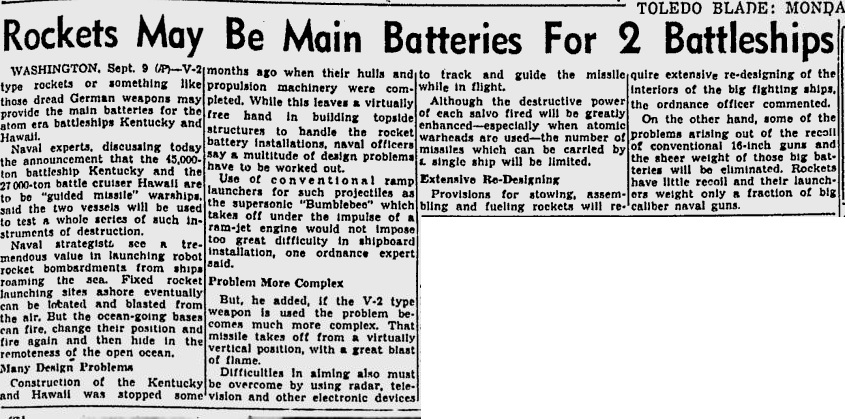
Firing a V-2 off an aircraft carrier
Germany’s V-2 ballistic missile was one of the most remarkable weapons of WWII, years ahead of it’s time. After the war, the US Army and civilian agencies fired captured examples for re…
Attachments
Grzesio
ACCESS: Secret
I just wonder, how they intended to transport the necessary liquid oxygen supply across the ocean?
There was a planned A 4 variant using nitric acid as an oxidizer, just it was nowhere close to production.
There was a planned A 4 variant using nitric acid as an oxidizer, just it was nowhere close to production.
This project was totally nonsense. Originally, the idea was, that bombing the US with few bombers will force them to invest heavyly in air defence. Despite problems with the feasibility, this idea wasn’t totally insane, few bomber over American cities would have been enough to urged the US to built up a defence system. When using rockets instead, there is nothing you can do to stop them, once they become airborne. The damage would have been diminishing, and no air defence system could have stopped them. Fighting submarines was already done and no additional effort would have been made for a few rocket launching submarines which took away plenty of resources from Germany but
Dilandu
I'm dissatisfied, which means, I exist.
I just wonder, how they intended to transport the necessary liquid oxygen supply across the ocean?
There was a planned A 4 variant using nitric acid as an oxidizer, just it was nowhere close to production.
In dewar flasks, it seems. Frankly, the whole project was so ridiculously problematic, that I wouldn't be surprised if no one actually even thought how this would work on practice...
Grzesio
ACCESS: Secret
Yep, I just wonder, how many LOX they would have needed to tank before such an Atlantic mission, to have 5 tonnes still left after crossing the ocean, as LOX cannot be prevented from evaporating.
According to Dornberger, 45 per cent of LOX were lost by evaporation during transport from factories and preflight preparations in normal A 4 service (i.e. 9 tonnes had to be produced to fill a rocket with 5 tonnes). Daily production in whole Germany in 1944 was up to 315 tonnes, what was enough for 28-30 combat launches and 5-7 test launches plus engine trials.
According to Dornberger, 45 per cent of LOX were lost by evaporation during transport from factories and preflight preparations in normal A 4 service (i.e. 9 tonnes had to be produced to fill a rocket with 5 tonnes). Daily production in whole Germany in 1944 was up to 315 tonnes, what was enough for 28-30 combat launches and 5-7 test launches plus engine trials.
T. A. Gardner
ACCESS: Top Secret
- Joined
- 18 February 2021
- Messages
- 876
- Reaction score
- 1,504
If they were using LOX, the submarine would have had to had a LOX plant onboard to make it to fuel the rocket. LOX wouldn't be easily storable for a transit taking as much as a couple of weeks to accomplish. That in itself would be a huge risk increase, not just from the danger of making, storing, and fueling the rocket with it, but the time the sub would have to sit on the surface making it.
The only viable alternative would be for the engineers to redesign the V-2 to use storable propellants using a new engine.
The only viable alternative would be for the engineers to redesign the V-2 to use storable propellants using a new engine.
williamjpellas
ACCESS: Confidential
- Joined
- 23 August 2021
- Messages
- 98
- Reaction score
- 35
This project was totally nonsense. Originally, the idea was, that bombing the US with few bombers will force them to invest heavyly in air defence. Despite problems with the feasibility, this idea wasn’t totally insane, few bomber over American cities would have been enough to urged the US to built up a defence system. When using rockets instead, there is nothing you can do to stop them, once they become airborne. The damage would have been diminishing, and no air defence system could have stopped them. Fighting submarines was already done and no additional effort would have been made for a few rocket launching submarines which took away plenty of resources from Germany but
It was not totally nonsense. Intelligence passed by Sweden to the British and then on to the Americans confirmed that the kriegsmarine was attempting to produce guided missiles that could be launched from submarines. This was further corroborated by a former US Naval Reserve seaman who defected to Nazi Germany during the war before being captured following his return to American soil as part of a sabotage operation.

William Colepaugh, The Connecticut Spy Who Went Out in the Maine Cold - New England Historical Society
During World War II, William Colepaugh had James Bond's love of women and his appetite for booze - just not his spy skills.
 www.newenglandhistoricalsociety.com
www.newenglandhistoricalsociety.com
Rocket U-boat - Wikipedia
H-047-1: Operation Teardrop
H-Gram 047, Attachment 1 Samuel J. Cox, Director NHHC May 2020
The American response was a US Navy battle plan known as "Operation Teardrop". This plan was activated when the approach of a u-boat "wolfpack" was detected very late in the war, in April 1945. The ensuing battle was furious and resulted in most of the German submarines being sunk. Two u-boat captains were captured and relentlessly beaten and tortured for information. This seems a rather extreme measure given that the outcome of the war was apparently no longer in doubt---unless the Americans were worried that German SLBM's or SLCM's, if they existed, might be armed with something other than conventional explosives.
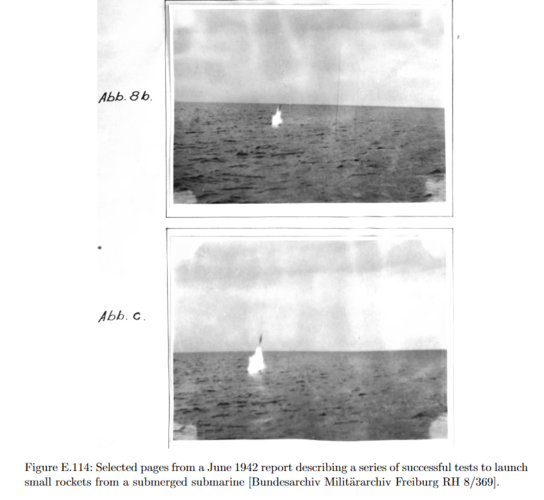
Most sources indicate that while prototypes had been built and tested, no submarine-launched guided missile capability actually became operational other than, perhaps, the barest handful of V-2 launch capsules which could have been towed into shooting range behind an otherwise more or less standard, late war u-boat. As with many late war - "wunderwaffen" technologies, the idea was perfectly sound. But it was seemingly too far ahead of its time to be perfected and brought to fully operational status given the numerous difficulties the Germans were facing by that point in the war. There is still a lot of smoke for there to have been no fire, though (see below).
Last edited:
williamjpellas
ACCESS: Confidential
- Joined
- 23 August 2021
- Messages
- 98
- Reaction score
- 35
Since szukający has already posted a link to Dr. Rider's book, I will add a link to his "German Atomic Bomb Slides" here:
Here are a few parts of Forgotten Creators which describe wartime German work on nuclear weapons and guided missiles---including submarine-launched variants---that were intended to deliver them against targets in the US mainland and elsewhere throughout Allied territory.
Page 4309:
"There is considerable evidence that fission bombs were successfully tested during the war (Sections D.2.5, D.2.6, and D.2.7), and that a hydrogen bomb was nearing completion when the war ended (Section D.2.4). Given the enormous amount of resources that would have been invested in developing nuclear weapons, and Germany’s desperate state late in the war, there must have been concrete plans and methods for delivering such weapons to Allied targets, including targets in the United States. In the usual German fashion, several different delivery methods, including aircraft and large missiles, were probably developed in parallel....
There is significant evidence that Germany was developing the following specific methods to deliver weapons of mass destruction (especially nuclear weapons) to Allied targets such as New York and Washington, D.C.:
1. There is documentary evidence for intercontinental bomber aircraft, and for nuclear weapons designed to be dropped by such aircraft (often dropped with a parachute, indicating that the expected blast was so large that the aircraft needed more time to escape to a safe distance after dropping the bomb). See for example: Postwar Allied discoveries of intercontinental jet bombers intended to attack the United States (Section E.2.1) Erwin Respondek (p. 3247) Werner Grothmann (pp. 3298 and 3384) Edmund Tilley (p. 3335)
2. There is documentary evidence that V-1 cruise missiles were modified to attack the United States with a payload sufficiently destructive to justify the mission. There were several different versions of the V-1 that could be ground-launched, submarine-launched, or air-launched from a large aircraft, and that were either unmanned or manned. See for example: Allied discoveries of piloted and air-launched V-1 missiles (p. 1695) Interrogation of Edmund Sorg regarding nuclear-armed V-1 missiles (pp. 3648–3649) Hans Kammler’s 23 April 1945 telegram ordering the destruction of special V-1s near Berlin to prevent them from being captured by Russian forces (p. 3649) Allied intelligence reports on submarine-launched V-1 missiles intended to attack the United States (pp. 4119–4126)
------------------------------------------------------------------------------------------------------------------------------------------------------
Page 4121:
Clayton Bissell and Hewlett Thebaud to the Joint Chiefs of Staff. 9 December 1944. Subject: Agreed Joint Evaluation of the Possible Existence of the V-3 Rocket and Probability of Attack against the U.S. [Franklin Delano Roosevelt Library, Hyde Park, New York. Map Room Files, Box 164, Folder Naval Aides. Files: A/16—General Correspondence]
1. The cable from Lieutenant Commander Earle, Naval Attach´e, Turkey is probably propaganda and represents a plant by the Germans. There is no reliable information available of German development of a long range rocket other than the V-2.
2. The V-3 may possibly be a rocket of smaller dimensions than the V-2 with a shorter range. It would be possible to launch such a missile from specially designed or modified submarines. Attached is a sketch of a German submarine based in a southern Norwegian port showing a pair of rails extending from conning tower to the bow and terminating at a flat, rectangular surface. The purpose of this is unknown.
3. German attack from Europe of United States cities by long range rockets is deemed impossible now. Small rocket or flying bomb attacks from specially constructed submarines are considered possible. Any such action would be made with propaganda effect rather than material damage as the primary objective.
Page 4123:
Clayton Bissell to Stockholm Military Attache. 3 November 1944. Outgoing Cable WAR 56799. [Franklin Delano Roosevelt Library, Hyde Park, New York. Map Room Files, Box 49, Folder Rocket Bombs 1944]
Have been advised through OSS that Tykander their representative in Stockholm has received reliable information that German U boats are equipped with bomb launching platforms. Investigate and keep us fully informed.
Page 4124:
U-Boat Aimed V-Bomb Here, Army Paper Says. New York Times. 15 May 1945 p. 10.
A German submarine tried to V-bomb New York last election day, presumably with a jet-propelled or rocket-propelled weapon, the Army newspaper Stars and Stripes reported tonight, quoting “sources considered reliable.” It was reported that the bomb was launched from the deck of a U-boat lying off the coast and that it fell short or was knocked down by fighter planes patrolling as a screen against any such projectiles. The Stars and Stripes said that “operators” at Mitchel Field were quoted as having said that it was determined that the bomb fell into the sea. The paper recalled that last Nov. 8, the day after the Presidential election, the Army and Navy in a joint statement said that a V-bomb attack on the United States was entirely possible. A Navy spokesman in Washington said that the report of the submarine attack was without foundation, The United Press reported. An official of the bomb squad of New York’s Police Department said last night that the squad had no knowledge of an attempted bombing of New York last Nov. 7 by the Germans. “Undoubtedly, if a robot bomb had been launched at New York from a U-boat, as reported, and had neared its objective, we would have been informed,” the spokesman said.
[Dr. Rider: "The original version of this story appeared as: U-Boat Aimed V-Bomb at New York, Stars and Stripes, 14 May 1945. Considering that the report came from the U.S. Army’s own newspaper and sources that they considered reliable, the subsequent denials by the U.S. Navy spokesman and New York bomb squad do not seem very convincing. If the incident actually occurred, can it be clarified if the weapon was a sub-launched V-1 cruise missile or something else? If the weapon fell into the sea, was it ever located? Was the warhead a conventional explosive, or a chemical, biological, or nuclear weapon? A V-1 strike on a U.S. city with only a conventional warhead would have done relatively little damage and would have had no strategic military value. For evidence of modified V-1 missiles that could have delivered weapons of mass destruction, see pp. 1695 and 3648–3649, as well as Henshall 2000, pp. 129–130."]
Page 4125:
Robot Bomb Attacks Here Held ‘Probable’ by Admiral. New York Times, 9 January 1945, pp. 1, 6. AN EAST COAST PORT, Jan. 8
A strategically futile attack on New York or Washington by robot bombs within thirty to sixty days was described today as not only “possible but probable” by Admiral Jonas H. Ingram, new Commander in Chief of the Atlantic Fleet, whose command stretches from the Arctic to the Falkland Islands. [...] “And we know very definitely that there are three ways in which he might get robot bombs within range of either city. He might sneak a half dozen submarines off the coast. He might launch robots from the long-range planes we know he has. Or he might sneak a surface ship, disguised as a neutral, within range.” [...] [See also: Officials Silent on Robot Threat/London Paper Predicts Attack. New York Times, 10 January 1945, p. 7.
-------------------------------------------------------------------------------------------------------------------------------------------
There are plenty of other intelligence reports and additional documents in Forgotten Creators that describe the German effort to develop submarine-launched guided missiles. As I stated above, intelligence such as you see here is what led to USN preparations to destroy any u-boats so armed should they be detected in time. PS Nearly all US files at NARA relating to the kriegsmarine nuclear scientist Otto Haxel remain classified and totally off limits to the public to this day. Why?
Here are a few parts of Forgotten Creators which describe wartime German work on nuclear weapons and guided missiles---including submarine-launched variants---that were intended to deliver them against targets in the US mainland and elsewhere throughout Allied territory.
Page 4309:
"There is considerable evidence that fission bombs were successfully tested during the war (Sections D.2.5, D.2.6, and D.2.7), and that a hydrogen bomb was nearing completion when the war ended (Section D.2.4). Given the enormous amount of resources that would have been invested in developing nuclear weapons, and Germany’s desperate state late in the war, there must have been concrete plans and methods for delivering such weapons to Allied targets, including targets in the United States. In the usual German fashion, several different delivery methods, including aircraft and large missiles, were probably developed in parallel....
There is significant evidence that Germany was developing the following specific methods to deliver weapons of mass destruction (especially nuclear weapons) to Allied targets such as New York and Washington, D.C.:
1. There is documentary evidence for intercontinental bomber aircraft, and for nuclear weapons designed to be dropped by such aircraft (often dropped with a parachute, indicating that the expected blast was so large that the aircraft needed more time to escape to a safe distance after dropping the bomb). See for example: Postwar Allied discoveries of intercontinental jet bombers intended to attack the United States (Section E.2.1) Erwin Respondek (p. 3247) Werner Grothmann (pp. 3298 and 3384) Edmund Tilley (p. 3335)
2. There is documentary evidence that V-1 cruise missiles were modified to attack the United States with a payload sufficiently destructive to justify the mission. There were several different versions of the V-1 that could be ground-launched, submarine-launched, or air-launched from a large aircraft, and that were either unmanned or manned. See for example: Allied discoveries of piloted and air-launched V-1 missiles (p. 1695) Interrogation of Edmund Sorg regarding nuclear-armed V-1 missiles (pp. 3648–3649) Hans Kammler’s 23 April 1945 telegram ordering the destruction of special V-1s near Berlin to prevent them from being captured by Russian forces (p. 3649) Allied intelligence reports on submarine-launched V-1 missiles intended to attack the United States (pp. 4119–4126)
------------------------------------------------------------------------------------------------------------------------------------------------------
Page 4121:
Clayton Bissell and Hewlett Thebaud to the Joint Chiefs of Staff. 9 December 1944. Subject: Agreed Joint Evaluation of the Possible Existence of the V-3 Rocket and Probability of Attack against the U.S. [Franklin Delano Roosevelt Library, Hyde Park, New York. Map Room Files, Box 164, Folder Naval Aides. Files: A/16—General Correspondence]
1. The cable from Lieutenant Commander Earle, Naval Attach´e, Turkey is probably propaganda and represents a plant by the Germans. There is no reliable information available of German development of a long range rocket other than the V-2.
2. The V-3 may possibly be a rocket of smaller dimensions than the V-2 with a shorter range. It would be possible to launch such a missile from specially designed or modified submarines. Attached is a sketch of a German submarine based in a southern Norwegian port showing a pair of rails extending from conning tower to the bow and terminating at a flat, rectangular surface. The purpose of this is unknown.
3. German attack from Europe of United States cities by long range rockets is deemed impossible now. Small rocket or flying bomb attacks from specially constructed submarines are considered possible. Any such action would be made with propaganda effect rather than material damage as the primary objective.
Page 4123:
Clayton Bissell to Stockholm Military Attache. 3 November 1944. Outgoing Cable WAR 56799. [Franklin Delano Roosevelt Library, Hyde Park, New York. Map Room Files, Box 49, Folder Rocket Bombs 1944]
Have been advised through OSS that Tykander their representative in Stockholm has received reliable information that German U boats are equipped with bomb launching platforms. Investigate and keep us fully informed.
Page 4124:
U-Boat Aimed V-Bomb Here, Army Paper Says. New York Times. 15 May 1945 p. 10.
A German submarine tried to V-bomb New York last election day, presumably with a jet-propelled or rocket-propelled weapon, the Army newspaper Stars and Stripes reported tonight, quoting “sources considered reliable.” It was reported that the bomb was launched from the deck of a U-boat lying off the coast and that it fell short or was knocked down by fighter planes patrolling as a screen against any such projectiles. The Stars and Stripes said that “operators” at Mitchel Field were quoted as having said that it was determined that the bomb fell into the sea. The paper recalled that last Nov. 8, the day after the Presidential election, the Army and Navy in a joint statement said that a V-bomb attack on the United States was entirely possible. A Navy spokesman in Washington said that the report of the submarine attack was without foundation, The United Press reported. An official of the bomb squad of New York’s Police Department said last night that the squad had no knowledge of an attempted bombing of New York last Nov. 7 by the Germans. “Undoubtedly, if a robot bomb had been launched at New York from a U-boat, as reported, and had neared its objective, we would have been informed,” the spokesman said.
[Dr. Rider: "The original version of this story appeared as: U-Boat Aimed V-Bomb at New York, Stars and Stripes, 14 May 1945. Considering that the report came from the U.S. Army’s own newspaper and sources that they considered reliable, the subsequent denials by the U.S. Navy spokesman and New York bomb squad do not seem very convincing. If the incident actually occurred, can it be clarified if the weapon was a sub-launched V-1 cruise missile or something else? If the weapon fell into the sea, was it ever located? Was the warhead a conventional explosive, or a chemical, biological, or nuclear weapon? A V-1 strike on a U.S. city with only a conventional warhead would have done relatively little damage and would have had no strategic military value. For evidence of modified V-1 missiles that could have delivered weapons of mass destruction, see pp. 1695 and 3648–3649, as well as Henshall 2000, pp. 129–130."]
Page 4125:
Robot Bomb Attacks Here Held ‘Probable’ by Admiral. New York Times, 9 January 1945, pp. 1, 6. AN EAST COAST PORT, Jan. 8
A strategically futile attack on New York or Washington by robot bombs within thirty to sixty days was described today as not only “possible but probable” by Admiral Jonas H. Ingram, new Commander in Chief of the Atlantic Fleet, whose command stretches from the Arctic to the Falkland Islands. [...] “And we know very definitely that there are three ways in which he might get robot bombs within range of either city. He might sneak a half dozen submarines off the coast. He might launch robots from the long-range planes we know he has. Or he might sneak a surface ship, disguised as a neutral, within range.” [...] [See also: Officials Silent on Robot Threat/London Paper Predicts Attack. New York Times, 10 January 1945, p. 7.
-------------------------------------------------------------------------------------------------------------------------------------------
There are plenty of other intelligence reports and additional documents in Forgotten Creators that describe the German effort to develop submarine-launched guided missiles. As I stated above, intelligence such as you see here is what led to USN preparations to destroy any u-boats so armed should they be detected in time. PS Nearly all US files at NARA relating to the kriegsmarine nuclear scientist Otto Haxel remain classified and totally off limits to the public to this day. Why?
Last edited:
T. A. Gardner
ACCESS: Top Secret
- Joined
- 18 February 2021
- Messages
- 876
- Reaction score
- 1,504
OMG! Not this crap again... We went through this same nonsense over on the Axis History board...Since szukający has already posted a link to Dr. Rider's book, I will add a link to his "German Atomic Bomb Slides" here:
Here are a few parts of Forgotten Creators which describe wartime German work on nuclear weapons and guided missiles---including submarine-launched variants---that were intended to deliver them against targets in the US mainland and elsewhere throughout Allied territory.
Page 4309:
"There is considerable evidence that fission bombs were successfully tested during the war (Sections D.2.5, D.2.6, and D.2.7), and that a hydrogen bomb was nearing completion when the war ended (Section D.2.4). Given the enormous amount of resources that would have been invested in developing nuclear weapons, and Germany’s desperate state late in the war, there must have been concrete plans and methods for delivering such weapons to Allied targets, including targets in the United States. In the usual German fashion, several different delivery methods, including aircraft and large missiles, were probably developed in parallel....
There is significant evidence that Germany was developing the following specific methods to deliver weapons of mass destruction (especially nuclear weapons) to Allied targets such as New York and Washington, D.C.:
1. There is documentary evidence for intercontinental bomber aircraft, and for nuclear weapons designed to be dropped by such aircraft (often dropped with a parachute, indicating that the expected blast was so large that the aircraft needed more time to escape to a safe distance after dropping the bomb). See for example: Postwar Allied discoveries of intercontinental jet bombers intended to attack the United States (Section E.2.1) Erwin Respondek (p. 3247) Werner Grothmann (pp. 3298 and 3384) Edmund Tilley (p. 3335)
2. There is documentary evidence that V-1 cruise missiles were modified to attack the United States with a payload sufficiently destructive to justify the mission. There were several different versions of the V-1 that could be ground-launched, submarine-launched, or air-launched from a large aircraft, and that were either unmanned or manned. See for example: Allied discoveries of piloted and air-launched V-1 missiles (p. 1695) Interrogation of Edmund Sorg regarding nuclear-armed V-1 missiles (pp. 3648–3649) Hans Kammler’s 23 April 1945 telegram ordering the destruction of special V-1s near Berlin to prevent them from being captured by Russian forces (p. 3649) Allied intelligence reports on submarine-launched V-1 missiles intended to attack the United States (pp. 4119–4126)
------------------------------------------------------------------------------------------------------------------------------------------------------
Page 4121:
Clayton Bissell and Hewlett Thebaud to the Joint Chiefs of Staff. 9 December 1944. Subject: Agreed Joint Evaluation of the Possible Existence of the V-3 Rocket and Probability of Attack against the U.S. [Franklin Delano Roosevelt Library, Hyde Park, New York. Map Room Files, Box 164, Folder Naval Aides. Files: A/16—General Correspondence]
1. The cable from Lieutenant Commander Earle, Naval Attach´e, Turkey is probably propaganda and represents a plant by the Germans. There is no reliable information available of German development of a long range rocket other than the V-2.
2. The V-3 may possibly be a rocket of smaller dimensions than the V-2 with a shorter range. It would be possible to launch such a missile from specially designed or modified submarines. Attached is a sketch of a German submarine based in a southern Norwegian port showing a pair of rails extending from conning tower to the bow and terminating at a flat, rectangular surface. The purpose of this is unknown.
3. German attack from Europe of United States cities by long range rockets is deemed impossible now. Small rocket or flying bomb attacks from specially constructed submarines are considered possible. Any such action would be made with propaganda effect rather than material damage as the primary objective.
Page 4123:
Clayton Bissell to Stockholm Military Attache. 3 November 1944. Outgoing Cable WAR 56799. [Franklin Delano Roosevelt Library, Hyde Park, New York. Map Room Files, Box 49, Folder Rocket Bombs 1944]
Have been advised through OSS that Tykander their representative in Stockholm has received reliable information that German U boats are equipped with bomb launching platforms. Investigate and keep us fully informed.
Page 4124:
U-Boat Aimed V-Bomb Here, Army Paper Says. New York Times. 15 May 1945 p. 10.
A German submarine tried to V-bomb New York last election day, presumably with a jet-propelled or rocket-propelled weapon, the Army newspaper Stars and Stripes reported tonight, quoting “sources considered reliable.” It was reported that the bomb was launched from the deck of a U-boat lying off the coast and that it fell short or was knocked down by fighter planes patrolling as a screen against any such projectiles. The Stars and Stripes said that “operators” at Mitchel Field were quoted as having said that it was determined that the bomb fell into the sea. The paper recalled that last Nov. 8, the day after the Presidential election, the Army and Navy in a joint statement said that a V-bomb attack on the United States was entirely possible. A Navy spokesman in Washington said that the report of the submarine attack was without foundation, The United Press reported. An official of the bomb squad of New York’s Police Department said last night that the squad had no knowledge of an attempted bombing of New York last Nov. 7 by the Germans. “Undoubtedly, if a robot bomb had been launched at New York from a U-boat, as reported, and had neared its objective, we would have been informed,” the spokesman said.
[Dr. Rider: "The original version of this story appeared as: U-Boat Aimed V-Bomb at New York, Stars and Stripes, 14 May 1945. Considering that the report came from the U.S. Army’s own newspaper and sources that they considered reliable, the subsequent denials by the U.S. Navy spokesman and New York bomb squad do not seem very convincing. If the incident actually occurred, can it be clarified if the weapon was a sub-launched V-1 cruise missile or something else? If the weapon fell into the sea, was it ever located? Was the warhead a conventional explosive, or a chemical, biological, or nuclear weapon? A V-1 strike on a U.S. city with only a conventional warhead would have done relatively little damage and would have had no strategic military value. For evidence of modified V-1 missiles that could have delivered weapons of mass destruction, see pp. 1695 and 3648–3649, as well as Henshall 2000, pp. 129–130."]
Page 4125:
Robot Bomb Attacks Here Held ‘Probable’ by Admiral. New York Times, 9 January 1945, pp. 1, 6. AN EAST COAST PORT, Jan. 8
A strategically futile attack on New York or Washington by robot bombs within thirty to sixty days was described today as not only “possible but probable” by Admiral Jonas H. Ingram, new Commander in Chief of the Atlantic Fleet, whose command stretches from the Arctic to the Falkland Islands. [...] “And we know very definitely that there are three ways in which he might get robot bombs within range of either city. He might sneak a half dozen submarines off the coast. He might launch robots from the long-range planes we know he has. Or he might sneak a surface ship, disguised as a neutral, within range.” [...] [See also: Officials Silent on Robot Threat/London Paper Predicts Attack. New York Times, 10 January 1945, p. 7.
------------------------------------------------------------------------------------------------------------------------------------------------------------------------------------------------------------------
There are plenty of other intelligence reports and additional documents in Forgotten Creators that describe the German effort to develop submarine-launched guided missiles. As I stated above, intelligence such as you see here is what led to USN preparations to destroy any u-boats so armed should they be detected in time. PS Nearly all US files at NARA relating to the kriegsmarine nuclear scientist Otto Haxel remain classified and totally off limits to the public to this day. Why?
Dilandu
I'm dissatisfied, which means, I exist.
As I said before; the whole project was so overcomplicated and absurd, that it probably existed more for political reason & milking money than for any practical reason. It would be an order of magnitude simpler to adapt V-1 for u-boat launching, and Kriegsmaine could not miss that (granted, V-1 was Luftwaffe project, and relations between them & navy weren't good). It almost looks like that someone decided to impress the Nazi leadership with extravagant and complex program, knowing perfectly that there is no way it could be done in time.If they were using LOX, the submarine would have had to had a LOX plant onboard to make it to fuel the rocket. LOX wouldn't be easily storable for a transit taking as much as a couple of weeks to accomplish. That in itself would be a huge risk increase, not just from the danger of making, storing, and fueling the rocket with it, but the time the sub would have to sit on the surface making it.
Dilandu
I'm dissatisfied, which means, I exist.
This seems a rather extreme measure given that the outcome of the war was apparently no longer in doubt---unless the Americans were worried that German SLBM's or SLCM's, if they existed, might be armed with something other than conventional explosives.
They were mostly worried that strikes against US coastline would cause public demands for increased defense of American continent - which would divert disproportionally large resources. The probability of Germans using chemical weapon that late in the was was considered as low, since all sources indicated that Nazi leadership was deathly afraid of the possibility of chemical warfare, and even removed & destroyed its own stockpiles to avoid the threat of unauthorised use.
- Joined
- 3 September 2006
- Messages
- 1,387
- Reaction score
- 1,209
can you please point to an online reference for this?Nazi leadership was deathly afraid of the possibility of chemical warfare, and even removed & destroyed its own stockpiles to avoid the threat of unauthorised use.
Grzesio
ACCESS: Secret
On the other hand, Kriegsmarine praised simplicity too and they found the Rheinbote as a long range weapon particularly well suited for U-Boots for attacking area targets. And that's why in mid 1944 a naval Rheinbote variant was ordered together with a launcher for submarines; it had to have 100 km range and carry a mediocre 130 kg warhead.It would be an order of magnitude simpler to adapt V-1 for u-boat launching, and Kriegsmaine could not miss that (granted, V-1 was Luftwaffe project, and relations between them & navy weren't good). It almost looks like that someone decided to impress the Nazi leadership with extravagant and complex program, knowing perfectly that there is no way it could be done in time.
Dilandu
I'm dissatisfied, which means, I exist.
Hm! Didn't know that. I toyed with the idea of Rheinbote as submarine weapon, but with its tiny warhead and very poor accuracy... Kinda weapon that opponent may not even notice being used...On the other hand, Kriegsmarine praised simplicity too and they found the Rheinbote as a long range weapon particularly well suited for U-Boots for attacking area targets. And that's why in mid 1944 a naval Rheinbote variant was ordered together with a launcher for submarines; it had to have 100 km range and carry a mediocre 130 kg warhead.
T. A. Gardner
ACCESS: Top Secret
- Joined
- 18 February 2021
- Messages
- 876
- Reaction score
- 1,504
I suspect the more grandiose and implausible a project was that offered--at least on paper--some respite from defeat for the Nazi leadership, the more they glommed onto it. For those 'working' on it, it was a way to keep that same leadership from drafting them and sending them to their death at the front.This seems a rather extreme measure given that the outcome of the war was apparently no longer in doubt---unless the Americans were worried that German SLBM's or SLCM's, if they existed, might be armed with something other than conventional explosives.
They were mostly worried that strikes against US coastline would cause public demands for increased defense of American continent - which would divert disproportionally large resources. The probability of Germans using chemical weapon that late in the was was considered as low, since all sources indicated that Nazi leadership was deathly afraid of the possibility of chemical warfare, and even removed & destroyed its own stockpiles to avoid the threat of unauthorised use.As I said before; the whole project was so overcomplicated and absurd, that it probably existed more for political reason & milking money than for any practical reason. It would be an order of magnitude simpler to adapt V-1 for u-boat launching, and Kriegsmaine could not miss that (granted, V-1 was Luftwaffe project, and relations between them & navy weren't good). It almost looks like that someone decided to impress the Nazi leadership with extravagant and complex program, knowing perfectly that there is no way it could be done in time.If they were using LOX, the submarine would have had to had a LOX plant onboard to make it to fuel the rocket. LOX wouldn't be easily storable for a transit taking as much as a couple of weeks to accomplish. That in itself would be a huge risk increase, not just from the danger of making, storing, and fueling the rocket with it, but the time the sub would have to sit on the surface making it.
As for the US, the continental US was hardly defenseless. The US had substantial defenses in place should the Germans or Japanese somehow manage an attack. Hundreds of planes patrolled up and down the coasts. The Navy deployed a variety of ASW ships off those coasts as well. There were massive coast defense installations and AA guns were deployed in defense of military installations as well as some civilian targets thought vulnerable.
OMG! Not this crap again... We went through this same nonsense over on the Axis History board...Since szukający has already posted a link to Dr. Rider's book, I will add a link to his "German Atomic Bomb Slides" here:
Here are a few parts of Forgotten Creators which describe wartime German work on nuclear weapons and guided missiles---including submarine-launched variants---that were intended to deliver them against targets in the US mainland and elsewhere throughout Allied territory.
Page 4309:
"There is considerable evidence that fission bombs were successfully tested during the war (Sections D.2.5, D.2.6, and D.2.7), and that a hydrogen bomb was nearing completion when the war ended (Section D.2.4). Given the enormous amount of resources that would have been invested in developing nuclear weapons, and Germany’s desperate state late in the war, there must have been concrete plans and methods for delivering such weapons to Allied targets, including targets in the United States. In the usual German fashion, several different delivery methods, including aircraft and large missiles, were probably developed in parallel....
There is significant evidence that Germany was developing the following specific methods to deliver weapons of mass destruction (especially nuclear weapons) to Allied targets such as New York and Washington, D.C.:
1. There is documentary evidence for intercontinental bomber aircraft, and for nuclear weapons designed to be dropped by such aircraft (often dropped with a parachute, indicating that the expected blast was so large that the aircraft needed more time to escape to a safe distance after dropping the bomb). See for example: Postwar Allied discoveries of intercontinental jet bombers intended to attack the United States (Section E.2.1) Erwin Respondek (p. 3247) Werner Grothmann (pp. 3298 and 3384) Edmund Tilley (p. 3335)
2. There is documentary evidence that V-1 cruise missiles were modified to attack the United States with a payload sufficiently destructive to justify the mission. There were several different versions of the V-1 that could be ground-launched, submarine-launched, or air-launched from a large aircraft, and that were either unmanned or manned. See for example: Allied discoveries of piloted and air-launched V-1 missiles (p. 1695) Interrogation of Edmund Sorg regarding nuclear-armed V-1 missiles (pp. 3648–3649) Hans Kammler’s 23 April 1945 telegram ordering the destruction of special V-1s near Berlin to prevent them from being captured by Russian forces (p. 3649) Allied intelligence reports on submarine-launched V-1 missiles intended to attack the United States (pp. 4119–4126)
------------------------------------------------------------------------------------------------------------------------------------------------------
Page 4121:
Clayton Bissell and Hewlett Thebaud to the Joint Chiefs of Staff. 9 December 1944. Subject: Agreed Joint Evaluation of the Possible Existence of the V-3 Rocket and Probability of Attack against the U.S. [Franklin Delano Roosevelt Library, Hyde Park, New York. Map Room Files, Box 164, Folder Naval Aides. Files: A/16—General Correspondence]
1. The cable from Lieutenant Commander Earle, Naval Attach´e, Turkey is probably propaganda and represents a plant by the Germans. There is no reliable information available of German development of a long range rocket other than the V-2.
2. The V-3 may possibly be a rocket of smaller dimensions than the V-2 with a shorter range. It would be possible to launch such a missile from specially designed or modified submarines. Attached is a sketch of a German submarine based in a southern Norwegian port showing a pair of rails extending from conning tower to the bow and terminating at a flat, rectangular surface. The purpose of this is unknown.
3. German attack from Europe of United States cities by long range rockets is deemed impossible now. Small rocket or flying bomb attacks from specially constructed submarines are considered possible. Any such action would be made with propaganda effect rather than material damage as the primary objective.
Page 4123:
Clayton Bissell to Stockholm Military Attache. 3 November 1944. Outgoing Cable WAR 56799. [Franklin Delano Roosevelt Library, Hyde Park, New York. Map Room Files, Box 49, Folder Rocket Bombs 1944]
Have been advised through OSS that Tykander their representative in Stockholm has received reliable information that German U boats are equipped with bomb launching platforms. Investigate and keep us fully informed.
Page 4124:
U-Boat Aimed V-Bomb Here, Army Paper Says. New York Times. 15 May 1945 p. 10.
A German submarine tried to V-bomb New York last election day, presumably with a jet-propelled or rocket-propelled weapon, the Army newspaper Stars and Stripes reported tonight, quoting “sources considered reliable.” It was reported that the bomb was launched from the deck of a U-boat lying off the coast and that it fell short or was knocked down by fighter planes patrolling as a screen against any such projectiles. The Stars and Stripes said that “operators” at Mitchel Field were quoted as having said that it was determined that the bomb fell into the sea. The paper recalled that last Nov. 8, the day after the Presidential election, the Army and Navy in a joint statement said that a V-bomb attack on the United States was entirely possible. A Navy spokesman in Washington said that the report of the submarine attack was without foundation, The United Press reported. An official of the bomb squad of New York’s Police Department said last night that the squad had no knowledge of an attempted bombing of New York last Nov. 7 by the Germans. “Undoubtedly, if a robot bomb had been launched at New York from a U-boat, as reported, and had neared its objective, we would have been informed,” the spokesman said.
[Dr. Rider: "The original version of this story appeared as: U-Boat Aimed V-Bomb at New York, Stars and Stripes, 14 May 1945. Considering that the report came from the U.S. Army’s own newspaper and sources that they considered reliable, the subsequent denials by the U.S. Navy spokesman and New York bomb squad do not seem very convincing. If the incident actually occurred, can it be clarified if the weapon was a sub-launched V-1 cruise missile or something else? If the weapon fell into the sea, was it ever located? Was the warhead a conventional explosive, or a chemical, biological, or nuclear weapon? A V-1 strike on a U.S. city with only a conventional warhead would have done relatively little damage and would have had no strategic military value. For evidence of modified V-1 missiles that could have delivered weapons of mass destruction, see pp. 1695 and 3648–3649, as well as Henshall 2000, pp. 129–130."]
Page 4125:
Robot Bomb Attacks Here Held ‘Probable’ by Admiral. New York Times, 9 January 1945, pp. 1, 6. AN EAST COAST PORT, Jan. 8
A strategically futile attack on New York or Washington by robot bombs within thirty to sixty days was described today as not only “possible but probable” by Admiral Jonas H. Ingram, new Commander in Chief of the Atlantic Fleet, whose command stretches from the Arctic to the Falkland Islands. [...] “And we know very definitely that there are three ways in which he might get robot bombs within range of either city. He might sneak a half dozen submarines off the coast. He might launch robots from the long-range planes we know he has. Or he might sneak a surface ship, disguised as a neutral, within range.” [...] [See also: Officials Silent on Robot Threat/London Paper Predicts Attack. New York Times, 10 January 1945, p. 7.
------------------------------------------------------------------------------------------------------------------------------------------------------------------------------------------------------------------
There are plenty of other intelligence reports and additional documents in Forgotten Creators that describe the German effort to develop submarine-launched guided missiles. As I stated above, intelligence such as you see here is what led to USN preparations to destroy any u-boats so armed should they be detected in time. PS Nearly all US files at NARA relating to the kriegsmarine nuclear scientist Otto Haxel remain classified and totally off limits to the public to this day. Why?
Instead of looking at the document sources mentioned, you throw up a smoke screen. You are not a researcher.
Hm! Didn't know that. I toyed with the idea of Rheinbote as submarine weapon, but with its tiny warhead and very poor accuracy... Kinda weapon that opponent may not even notice being used...
As long as weapons of mass destruction are the only feasable option, the accuracy is not important.
If they were using LOX, the submarine would have had to had a LOX plant onboard to make it to fuel the rocket. LOX wouldn't be easily storable for a transit taking as much as a couple of weeks to accomplish. That in itself would be a huge risk increase, not just from the danger of making, storing, and fueling the rocket with it, but the time the sub would have to sit on the surface making it.
The only viable alternative would be for the engineers to redesign the V-2 to use storable propellants using a new engine.
"only viable"? What do you know about liquid oxygen storage from the period?
| AIR 40/2539 | |
| Description: | Liquid oxygen and hydrogen peroxide: production and storage: report by team from SHAEF during visits to France and Belgium. Includes 30 photographs depicting: `Crossbow' sites, interpretation reports: underground oxygen plant, Wittring, France - production of oxygen & nitrogen associated with VI or V2 weapons; machinery etc, interior views; German rail tankers carrying liquefied gas; (aerial mosaics). Dated 1944-1945. |
|---|
Dilandu
I'm dissatisfied, which means, I exist.
I rather doubt that the rocket with very poor accuracy and warhead of about 100 kg could be called "weapon of mass destruction". If I recall correctly, Germans were unable to actually determine what is the CEP of "Rheinbote", because they could not find the craters from it...As long as weapons of mass destruction are the only feasable option, the accuracy is not important.
Dilandu
I'm dissatisfied, which means, I exist.
I never said that it was defenseless; just that missile strikes may cause more resources diverted to calm the population. Which wouldn't change course of the war the slighters, but would be enough annoyance for US military (especially logistic) for such possibility to be avoided.As for the US, the continental US was hardly defenseless. The US had substantial defenses in place should the Germans or Japanese somehow manage an attack. Hundreds of planes patrolled up and down the coasts. The Navy deployed a variety of ASW ships off those coasts as well. There were massive coast defense installations and AA guns were deployed in defense of military installations as well as some civilian targets thought vulnerable.
Well, a common joke is that Germany produced so many implausible designs because German engineers REALLY did not want to be conscrpited & send to Eastern Front...I suspect the more grandiose and implausible a project was that offered--at least on paper--some respite from defeat for the Nazi leadership, the more they glommed onto it. For those 'working' on it, it was a way to keep that same leadership from drafting them and sending them to their death at the front.
Dilandu
I'm dissatisfied, which means, I exist.
Instead of looking at the document sources mentioned, you throw up a smoke screen. You are not a researcher.
(melancholically) I wonder, why they always invent tales about German atomic superweapon, but never about Italian? Or Soviet, for that matter? The first design for atomic bomb was actually suggested in USSR in 1940. Granted, it was unworkable (it was based on assumptions that were eventually disproved), but still.
Using rockets with such an effort and only a small warhead makes only sence for weapons of mass destruction. Obviously, there is no indication for that and neither chemical or biological weapons have ever been used by the third Reich, so its all speculation.
In theory, even the small usefull load of the Rheinbote could have caused some panic, if chemical or biological rockets would have been spread in a dense populated area (again, nor pressison needed)
In theory, even the small usefull load of the Rheinbote could have caused some panic, if chemical or biological rockets would have been spread in a dense populated area (again, nor pressison needed)
Using rockets with such an effort and only a small warhead makes only sence for weapons of mass destruction. Obviously, there is no indication for that and neither chemical or biological weapons have ever been used by the third Reich, so its all speculation.
In theory, even the small usefull load of the Rheinbote could have caused some panic, if chemical or biological rockets would have been spread in a dense populated area (again, nor pressison needed)
"... its all speculation." How much research have you done? How many document references do you have that confirms this? In December,
1944, a document reports that preparations need to be made for an "intercontinental missile attack."
"Preparing the American Public for a V-3 Attack, Dec 1944, US Historical Research Center, Maxwell Air Force Base, Montgomery, Alabama, L/C Box 223, USAF Microfilm Reel 43811.
Dilandu
I'm dissatisfied, which means, I exist.
Logically yes, but Nazi leadership wasn't thinking logically. They thought mainly in terms of "moral victory" and "making an impression" and persuaded themselves that if they dropped a few bombs on New York, it would cause panick and "morally weak American democracy" would sue for peace out of fear. Of course it was utterly absurd, but since Nazi leadership wanted to believe in it...Using rockets with such an effort and only a small warhead makes only sence for weapons of mass destruction. Obviously, there is no indication for that and neither chemical or biological weapons have ever been used by the third Reich, so its all speculation.
Dilandu
I'm dissatisfied, which means, I exist.
Chemical weapon must be dispersed properly. Which isn't exactly very simple. Since Germany did not have workable proximity fuze, releasing chemical agents before impact was out of question, so essentially the warhead would just splash the chemicals around at the moment of impact. Not a very efficient way; basically you would have a toxic puddle inside the (small) crater and hardly anything more.To confirm what? That a chamical weapon could cause some panic, even with a small warhead?
Dilandu
I'm dissatisfied, which means, I exist.
Look, let's be serious. The only "wunderwaffe" that Nazi actually produced was chlorine trifluoride, the N-stoff. And they (as well as everyone else after them) could not figure out how to actually deliver this hellish substance to the enemy, without killing order of magnitude of your own troops in process. I agree, that chlorine trifluoride warhead, hitting New York, would actually be... worrysome enough for US to became really concerned. But there were no way to deliver it, plain & simple. This substance is corrosive to the point when it could be used as exemplification of corrosive substances, and could be transported only with greatest care."... its all speculation." How much research have you done? How many document references do you have that confirms this? In December,
1944, a document reports that preparations need to be made for an "intercontinental missile attack."
"Preparing the American Public for a V-3 Attack, Dec 1944, US Historical Research Center, Maxwell Air Force Base, Montgomery, Alabama, L/C Box 223, USAF Microfilm Reel 43811.
- Joined
- 27 December 2005
- Messages
- 16,415
- Reaction score
- 18,950
Instead of looking at the document sources mentioned, you throw up a smoke screen. You are not a researcher.
“All of this has happened before, and it will all happen again.”
― J.M. Barrie , Peter Pan
T. A. Gardner
ACCESS: Top Secret
- Joined
- 18 February 2021
- Messages
- 876
- Reaction score
- 1,504
I linked to a thread on another board where I already went through this with Pellas et. al., possibly even you, and demolished this nonsense. Why should I do it again when it's there to be read?OMG! Not this crap again... We went through this same nonsense over on the Axis History board...Since szukający has already posted a link to Dr. Rider's book, I will add a link to his "German Atomic Bomb Slides" here:
Here are a few parts of Forgotten Creators which describe wartime German work on nuclear weapons and guided missiles---including submarine-launched variants---that were intended to deliver them against targets in the US mainland and elsewhere throughout Allied territory.
Page 4309:
"There is considerable evidence that fission bombs were successfully tested during the war (Sections D.2.5, D.2.6, and D.2.7), and that a hydrogen bomb was nearing completion when the war ended (Section D.2.4). Given the enormous amount of resources that would have been invested in developing nuclear weapons, and Germany’s desperate state late in the war, there must have been concrete plans and methods for delivering such weapons to Allied targets, including targets in the United States. In the usual German fashion, several different delivery methods, including aircraft and large missiles, were probably developed in parallel....
There is significant evidence that Germany was developing the following specific methods to deliver weapons of mass destruction (especially nuclear weapons) to Allied targets such as New York and Washington, D.C.:
1. There is documentary evidence for intercontinental bomber aircraft, and for nuclear weapons designed to be dropped by such aircraft (often dropped with a parachute, indicating that the expected blast was so large that the aircraft needed more time to escape to a safe distance after dropping the bomb). See for example: Postwar Allied discoveries of intercontinental jet bombers intended to attack the United States (Section E.2.1) Erwin Respondek (p. 3247) Werner Grothmann (pp. 3298 and 3384) Edmund Tilley (p. 3335)
2. There is documentary evidence that V-1 cruise missiles were modified to attack the United States with a payload sufficiently destructive to justify the mission. There were several different versions of the V-1 that could be ground-launched, submarine-launched, or air-launched from a large aircraft, and that were either unmanned or manned. See for example: Allied discoveries of piloted and air-launched V-1 missiles (p. 1695) Interrogation of Edmund Sorg regarding nuclear-armed V-1 missiles (pp. 3648–3649) Hans Kammler’s 23 April 1945 telegram ordering the destruction of special V-1s near Berlin to prevent them from being captured by Russian forces (p. 3649) Allied intelligence reports on submarine-launched V-1 missiles intended to attack the United States (pp. 4119–4126)
------------------------------------------------------------------------------------------------------------------------------------------------------
Page 4121:
Clayton Bissell and Hewlett Thebaud to the Joint Chiefs of Staff. 9 December 1944. Subject: Agreed Joint Evaluation of the Possible Existence of the V-3 Rocket and Probability of Attack against the U.S. [Franklin Delano Roosevelt Library, Hyde Park, New York. Map Room Files, Box 164, Folder Naval Aides. Files: A/16—General Correspondence]
1. The cable from Lieutenant Commander Earle, Naval Attach´e, Turkey is probably propaganda and represents a plant by the Germans. There is no reliable information available of German development of a long range rocket other than the V-2.
2. The V-3 may possibly be a rocket of smaller dimensions than the V-2 with a shorter range. It would be possible to launch such a missile from specially designed or modified submarines. Attached is a sketch of a German submarine based in a southern Norwegian port showing a pair of rails extending from conning tower to the bow and terminating at a flat, rectangular surface. The purpose of this is unknown.
3. German attack from Europe of United States cities by long range rockets is deemed impossible now. Small rocket or flying bomb attacks from specially constructed submarines are considered possible. Any such action would be made with propaganda effect rather than material damage as the primary objective.
Page 4123:
Clayton Bissell to Stockholm Military Attache. 3 November 1944. Outgoing Cable WAR 56799. [Franklin Delano Roosevelt Library, Hyde Park, New York. Map Room Files, Box 49, Folder Rocket Bombs 1944]
Have been advised through OSS that Tykander their representative in Stockholm has received reliable information that German U boats are equipped with bomb launching platforms. Investigate and keep us fully informed.
Page 4124:
U-Boat Aimed V-Bomb Here, Army Paper Says. New York Times. 15 May 1945 p. 10.
A German submarine tried to V-bomb New York last election day, presumably with a jet-propelled or rocket-propelled weapon, the Army newspaper Stars and Stripes reported tonight, quoting “sources considered reliable.” It was reported that the bomb was launched from the deck of a U-boat lying off the coast and that it fell short or was knocked down by fighter planes patrolling as a screen against any such projectiles. The Stars and Stripes said that “operators” at Mitchel Field were quoted as having said that it was determined that the bomb fell into the sea. The paper recalled that last Nov. 8, the day after the Presidential election, the Army and Navy in a joint statement said that a V-bomb attack on the United States was entirely possible. A Navy spokesman in Washington said that the report of the submarine attack was without foundation, The United Press reported. An official of the bomb squad of New York’s Police Department said last night that the squad had no knowledge of an attempted bombing of New York last Nov. 7 by the Germans. “Undoubtedly, if a robot bomb had been launched at New York from a U-boat, as reported, and had neared its objective, we would have been informed,” the spokesman said.
[Dr. Rider: "The original version of this story appeared as: U-Boat Aimed V-Bomb at New York, Stars and Stripes, 14 May 1945. Considering that the report came from the U.S. Army’s own newspaper and sources that they considered reliable, the subsequent denials by the U.S. Navy spokesman and New York bomb squad do not seem very convincing. If the incident actually occurred, can it be clarified if the weapon was a sub-launched V-1 cruise missile or something else? If the weapon fell into the sea, was it ever located? Was the warhead a conventional explosive, or a chemical, biological, or nuclear weapon? A V-1 strike on a U.S. city with only a conventional warhead would have done relatively little damage and would have had no strategic military value. For evidence of modified V-1 missiles that could have delivered weapons of mass destruction, see pp. 1695 and 3648–3649, as well as Henshall 2000, pp. 129–130."]
Page 4125:
Robot Bomb Attacks Here Held ‘Probable’ by Admiral. New York Times, 9 January 1945, pp. 1, 6. AN EAST COAST PORT, Jan. 8
A strategically futile attack on New York or Washington by robot bombs within thirty to sixty days was described today as not only “possible but probable” by Admiral Jonas H. Ingram, new Commander in Chief of the Atlantic Fleet, whose command stretches from the Arctic to the Falkland Islands. [...] “And we know very definitely that there are three ways in which he might get robot bombs within range of either city. He might sneak a half dozen submarines off the coast. He might launch robots from the long-range planes we know he has. Or he might sneak a surface ship, disguised as a neutral, within range.” [...] [See also: Officials Silent on Robot Threat/London Paper Predicts Attack. New York Times, 10 January 1945, p. 7.
------------------------------------------------------------------------------------------------------------------------------------------------------------------------------------------------------------------
There are plenty of other intelligence reports and additional documents in Forgotten Creators that describe the German effort to develop submarine-launched guided missiles. As I stated above, intelligence such as you see here is what led to USN preparations to destroy any u-boats so armed should they be detected in time. PS Nearly all US files at NARA relating to the kriegsmarine nuclear scientist Otto Haxel remain classified and totally off limits to the public to this day. Why?
Instead of looking at the document sources mentioned, you throw up a smoke screen. You are not a researcher.
T. A. Gardner
ACCESS: Top Secret
- Joined
- 18 February 2021
- Messages
- 876
- Reaction score
- 1,504
Well, as far as I know, the Germans didn't do what the US did (not sure about Britain), and that is simply induct these researchers, technicians, engineers, etc., that were vulnerable to being drafted, promote them instantly to an appropriate rank and then give them orders that put them right back in their same civilian position only now in uniform.I never said that it was defenseless; just that missile strikes may cause more resources diverted to calm the population. Which wouldn't change course of the war the slighters, but would be enough annoyance for US military (especially logistic) for such possibility to be avoided.As for the US, the continental US was hardly defenseless. The US had substantial defenses in place should the Germans or Japanese somehow manage an attack. Hundreds of planes patrolled up and down the coasts. The Navy deployed a variety of ASW ships off those coasts as well. There were massive coast defense installations and AA guns were deployed in defense of military installations as well as some civilian targets thought vulnerable.
Well, a common joke is that Germany produced so many implausible designs because German engineers REALLY did not want to be conscrpited & send to Eastern Front...I suspect the more grandiose and implausible a project was that offered--at least on paper--some respite from defeat for the Nazi leadership, the more they glommed onto it. For those 'working' on it, it was a way to keep that same leadership from drafting them and sending them to their death at the front.
At the Rad Lab at MIT there were a good number of US Army officers and enlisted of high rank who had zero medals, etc., on their uniforms but were really in the military just to avoid their being drafted.
- Status
- Not open for further replies.
Similar threads
-
-
-
-
Ferry Rocket, Star Clipper, Astrorocket articles
- Started by Orionblamblam
- Replies: 17
-

